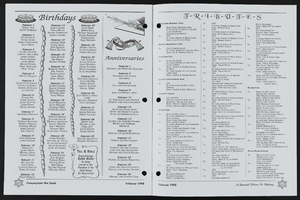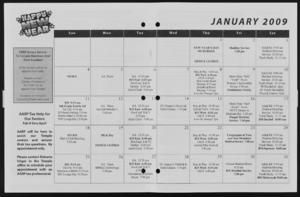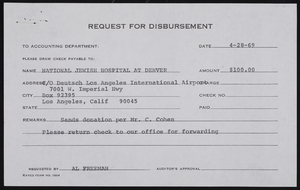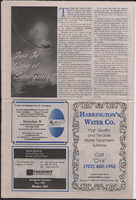Search the Special Collections and Archives Portal
Search Results

Transcript of interview with Diana Saunders by Barbara Tabach, April 17, 2017
Date
Archival Collection
Description
Diana Saunders was born Diana Salshutz in the Bronx, the northern most borough of New York City. She was raised in a Jewish neighborhood and recalls how her maternal grandparents pickled pickles, tomatoes and other traditional Jewish delicacies for Wolfie?s Deli. By the time she was twelve years old, Diana was bustling through the city to pursue her dream of becoming a professional dancer. Encouraged by her mother Rose?her father Sidney was not as eager for this pursuit?Diana was accepted into High School of Performing Arts in Manhattan. In addition, she was accepted at the School of American Ballet where she studied classical ballet during the leadership of renowned choreographer George Balanchine. Her first professional performance was in the Nutcracker for American Ballet. At the age of seventeen, Diana was on her own, confident in her dancing potential, and eager to study jazz dancing. This led her to Matt Mattox and to her important mentor, Luigi (Eugene Louis Faccuito). In time she was a featured dancer for Steven Lawrence and Eydie Gorm?s show Golden Rainbow. This was soon followed by a position on Sammy Davis Jr.?s television show in the 1960s. Diana also studied musical acting and showed talent for comedic performance. In the 1970s, Diana crossed paths with Las Vegas venues. She relocated to Las Vegas in 1974 when Donn Arden offered her a dancer position in Hallelujah Hollywood at the MGM. She met and married musical theater actor/singer Joe Bellomo, whose career spanned four decades. He passed away of complications of early onset Alzheimer?s in 1996. Always true to her personal mantra?Wake up; Dress up. Show up?Diana maintains a busy schedule. At the time of this of this interview, she is currently a manger of gondoliers at the Venetian. She brings to life that career and also talks about being a part of the former Star Trek Experience at the Las Vegas Hilton. Diana shares stories of long career as a dancer, from substituting in the black dancer line to continued study of dancing with Anglo Moio. She also talks about the AIDS fundraising event Golden Rainbow, having dinner at Rabbi Shea Harlig?s home and observations of local theater.
Text
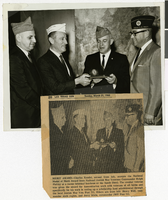
Photograph of Charles Kandel accepting the National Medal of Merit Award, Las Vegas (Nev.), March 21, 1965
Date
Archival Collection
Description
Newspaper clipping description reads: "LAS VEGAS SUN. Sunday, March 21, 1965. MERIT AWARD - Charles Kandel, second from left, accepts the National Medal of Merit Award from National Jewish War Veterans Commander Ralph Plofsky at a recent informal luncheon at the Sands Hotel. The combat veteran was given the award for humanitarian work with veterans of all faiths and specifically for his work in setting up a scholarship fund administered through the local Jewish War Vets Post 711. Others are from left: Henry Wolf, commander six region, and Jerry Klein, commander JWV Post 711."
Image

Dr. Ruben J. Acherman interview, July 18, 2019: transcript
Date
Archival Collection
Description
Interviewed by Monsserath Hernandez, Laurents Bañuelos-Benitez, and Claytee White. Dr. Acherman has been practicing in Southern Nevada for nearly 20 years and continues to care for the community at the Children's Heart Center of Nevada in Las Vegas. Born and raised in the small town of Palmira, Colombia with his two sisters and parents. His father is from Romania and immigrated to Ecuador while escaping from Nazi occupied Europe during World War II. Dr. Acherman eventually moved to Cali, Colombia in order to attend medical school. knowing that he wanted to specialize in cardiology and being unable to do cardiology in Colombia he immigrated to the U.S. and specialized in pediatrics at USC. After practicing for two years in Toronto, he was contacted by Dr. Evans in 2001 with an offer to work at his practice in Southern Nevada where he was able to successfully perform the first balloon dilation in the state of Nevada.
Text
Steve Riback oral history interview
Identifier
Abstract
Oral history interview with Steve Riback conducted by Barbara Tabach on December 12, 2017 for the Southern Nevada Jewish Heritage Project. Steve Riback is a detective sergeant for the Las Vegas Metropolitan Police Department. He has been with the police force for nearly twenty years. He reflects on his overwhelming pride of the police on October 1, 2017. Riback recalls what he heard on his police radio, seeing the rush of police cars being dispatched, and watching a body camera video later. Sgt. Riback’s squad was assigned to Spring Valley Hospital where they worked tirelessly to identify victims, both injured and deceased. His reflections stir the image of medical professionals and police officers urgently fusing together to handle the situation at hand. Riback shares a myriad of emotions, and talks about the options available for officers to deal with their personal trauma.
Archival Collection
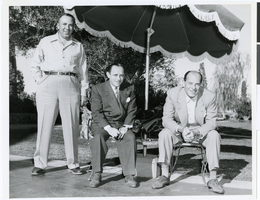
Photograph of Gus Greenbaum and Moe Sedway, 1940s-early 1950s
Date
Archival Collection
Description
Gus Greenbaum (right), Moe Sedway (center), and an unidentified man (left) most likely in Las Vegas, Nevada.
Image
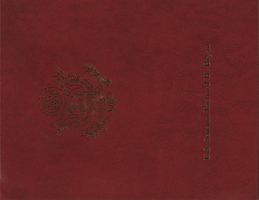
Awards and certificates for Edythe Katz, 1968-2001
Date
Archival Collection
Description
Select awards and certificates given to Edythe Katz for her involvement in the community.
Text

